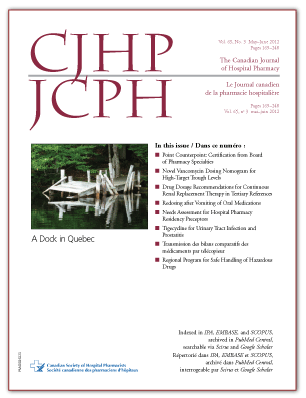Vomiting of Oral Medications by Pediatric Patients: Survey of Medication Redosing Practices
DOI:
https://doi.org/10.4212/cjhp.v65i3.1142Keywords:
vomiting, pediatric, oral medication, survey, vomissements, enfants, médicaments oraux, sondageAbstract
ABSTRACT
Background: At the time of this study, the authors’ pediatric tertiary care hospital had no policy to guide actions when a child vomited after ingesting oral medication, and limited information was available in the literature.
Objectives: To characterize this clinical problem at the study hospital, to identify current practices related to redosing of medications at the study hospital, and to collect guidelines and opinions of health care professionals at other pediatric hospitals on this topic.
Methods: Two online surveys were conducted, each over a 1-month period in late 2010, to identify current practices and opinions of pediatric health care professionals about redosing of medications after vomiting. E-mail distribution lists and health care forums were used to recruit participants.
Results: Of the 76 responses from the study hospital, 65 were suitable for analysis. Many respondents reported encountering vomiting after administration of oral medications on a weekly (25 [38%]) or monthly (24 [37%]) basis. Most of the respondents reported that they would follow a general rule to redose if vomiting occurred within 30 min (39 [60%]) or 15 min (21 [32%]) after initial ingestion. When respondents were asked to rate the importance of 8 factors potentially affecting the decision to redose, more than half indicated that time after dose ingestion (59 [91%]), medication type (45 [69%]), patient status (39 [60%]), and visibility of medication in the vomitus (36 [55%]) were very important. Of the 53 respondents to the survey of health care professionals at other institutions, 16 (30%) indicated that their pediatric hospital or ward had a guideline on redosing in cases of vomiting after administration of oral medications. Most respondents (12/13 [92%]) stated that the guideline took into account the interval between initial ingestion and vomiting.
Conclusions: The problem of vomiting after administration of an oral medication was prevalent at the study hospital, and guidelines were scarce at other pediatric institutions. Health care professionals at the study hospital and other institutions listed the time between ingestion and vomiting as the most important factor in the decision to redose the medication.
RÉSUMÉ
Contexte : Au moment de cette étude, l’hôpital de soins tertiaires pour enfants où les auteurs pratiquent n’avait aucune politique guidant les mesures à prendre chez un enfant qui vomissait après l’ingestion de médicaments par voie orale, et on trouvait peu d’information sur ce sujet dans la littérature.
Objectifs : Caractériser ce problème clinique à l’hôpital en question, déterminer les pratiques actuelles de réadministration des médicaments et consigner les lignes directrices et les opinions pertinentes des professionnels de la santé d’autres hôpitaux pour enfants.
Méthodes : Deux sondages en ligne ont été effectués, chacun sur une période d’un mois à la fin de 2010, afin de définir les pratiques et les opinions actuelles des professionnels des soins de santé pédiatriques concernant la réadministration des médicaments après les vomissements. Des listes de diffusion par courriel et des forums de soins de santé ont servi à recruter les participants.
Résultats : Des 76 réponses reçues à cet hôpital, 65 ont été retenues aux fins d’analyse. De nombreux répondants ont déclaré rencontrer des cas de vomissements après l’administration de médicaments par voie orale sur une base hebdomadaire (25 [38 %]) ou mensuelle (24 [37 %]). La plupart des répondants ont déclaré observer une règle générale voulant qu’on réadministre le médicament si l’enfant vomissait dans les 30 minutes (39 [60 %]) ou les 15 minutes (21 [32 %]) suivant l’administration initiale du médicament. En réponse à la question sur l’importance relative de 8 facteurs ayant une incidence possible sur la décision de réadministrer le médicament, plus de la moitié des répondants ont indiqué que le temps écoulé après l’ingestion du médicament (59 [91 %]), le type de medicament (45 [69 %]), l’état du patient (39 [60 %]) et la visibilité du medicament dans les vomissements (36 [55 %]) étaient très importants. Des 53 répondants du sondage auprès des professionnels de la santé d’autres établissements, 16 (30 %) ont indiqué que leur hôpital pour enfants ou le service de soins aux enfants possédait des lignes directrices sur la conduit à tenir en cas de vomissements après l’administration de medicaments par voie orale. La plupart de ces répondants (92 % [12/13]) ont declare que les lignes directrices tenaient compte du temps écoulé après l’administration du médicament.
Conclusions : Le problème des vomissements après l’administration de médicaments par voie orale était fréquent à cet hôpital et des lignes directrices sur la conduite à tenir dans ces cas étaient disponibles dans seulement quelques autres hôpitaux pour enfants. Les professionnels de la santé de cet établissement et d’autres établissements ont déclaré que le temps écoulé entre l’ingestion du médicament et le vomissement était le facteur le plus important dans la décision d’administrer une nouvelle dose du médicament.
Downloads
Published
Issue
Section
License
Copyright © Canadian Society of Healthcare-Systems Pharmacy.
After publication of a manuscript in the CJHP, the authors of the manuscript must obtain written permission from the CSHP (publications@cshp.ca) before reproducing any text, figures, tables, or illustrations from the work in future works of their own. If a submitted manuscript is declined for publication in the CJHP, all said rights shall revert to the authors. Please note that any forms (e.g., preprinted orders and patient intake forms) used by a specific hospital or other health care facility and included as illustrative material with a manuscript are exempt from this copyright transfer. The CJHP will require a letter from the hospital or health care facility granting permission to publish the document(s).










